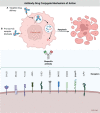Targeted Delivery of Chemotherapeutic Agents for Osteosarcoma Treatment
- PMID: 35311145
- PMCID: PMC8931218
- DOI: 10.3389/fonc.2022.843345
Targeted Delivery of Chemotherapeutic Agents for Osteosarcoma Treatment
Abstract
Since osteosarcoma (OS) is an aggressive bone cancer with unknown molecular pathways of etiology and pathophysiology, improving patient survival has long been a challenge. The conventional therapy is a complex multidisciplinary management that include radiotherapy, chemotherapy which followed by surgery and then post-operative adjuvant chemotherapy. However, they have severe side effects because the majority of the medicines used have just a minor selectivity for malignant tissue. As a result, treating tumor cells specifically without damaging healthy tissue is currently a primary goal in OS therapy. The coupling of chemotherapeutic drugs with targeting ligands is a unique therapy method for OS that, by active targeting, can overcome the aforementioned hurdles. This review focuses on advances in ligands and chemotherapeutic agents employed in targeted delivery to improve the capacity of active targeting and provide some insight into future therapeutic research for OS.
Keywords: antibodies; chemotherapeutic agents; ligand-based delivery systems; osteosarcoma; targeted delivery.
Copyright © 2022 Xie, Wang, Li, Guo, Lu and Liang.
Conflict of interest statement
The authors declare that the research was conducted in the absence of any commercial or financial relationships that could be construed as a potential conflict of interest.
Figures




Similar articles
-
Active targeting schemes for nano-drug delivery systems in osteosarcoma therapeutics.J Nanobiotechnology. 2023 Mar 22;21(1):103. doi: 10.1186/s12951-023-01826-1. J Nanobiotechnology. 2023. PMID: 36944946 Free PMC article. Review.
-
Drug delivery nanocarriers and recent advances ventured to improve therapeutic efficacy against osteosarcoma: an overview.J Egypt Natl Canc Inst. 2021 Feb 8;33(1):4. doi: 10.1186/s43046-021-00059-3. J Egypt Natl Canc Inst. 2021. PMID: 33555490 Review.
-
Osteosarcoma: review of the past, impact on the future. The American experience.Cancer Treat Res. 2009;152:239-62. doi: 10.1007/978-1-4419-0284-9_12. Cancer Treat Res. 2009. PMID: 20213394 Review.
-
Advances in Bone-targeted Drug Delivery Systems for Neoadjuvant Chemotherapy for Osteosarcoma.Orthop Surg. 2016 May;8(2):105-10. doi: 10.1111/os.12238. Orthop Surg. 2016. PMID: 27384718 Free PMC article. Review.
-
Surface engineering of nanoparticles with ligands for targeted delivery to osteosarcoma.Colloids Surf B Biointerfaces. 2020 Jun;190:110891. doi: 10.1016/j.colsurfb.2020.110891. Epub 2020 Feb 21. Colloids Surf B Biointerfaces. 2020. PMID: 32114271 Review.
Cited by
-
Role of proteoglycan synthesis genes in osteosarcoma stem cells.Front Oncol. 2024 Apr 16;14:1325794. doi: 10.3389/fonc.2024.1325794. eCollection 2024. Front Oncol. 2024. PMID: 38690160 Free PMC article.
-
Current Role of Topoisomerase I Inhibitors for the Treatment of Mesenchymal Malignancies and Their Potential Future Use as Payload of Sarcoma-Specific Antibody-Drug Conjugates.Oncol Res Treat. 2024;47(1-2):18-41. doi: 10.1159/000535491. Epub 2023 Nov 28. Oncol Res Treat. 2024. PMID: 38016427 Free PMC article. Review.
-
Imatinib-Functionalized Galactose Hydrogels Loaded with Nanohydroxyapatite as a Drug Delivery System for Osteosarcoma: In Vitro Studies.ACS Omega. 2023 May 9;8(20):17891-17900. doi: 10.1021/acsomega.3c00986. eCollection 2023 May 23. ACS Omega. 2023. PMID: 37251195 Free PMC article.
-
Recurrent Osteosarcoma Presenting as Hepatic Metastasis: A Case Report.Cureus. 2024 Nov 5;16(11):e73087. doi: 10.7759/cureus.73087. eCollection 2024 Nov. Cureus. 2024. PMID: 39650980 Free PMC article.
-
Current Status and Prospects of Targeted Therapy for Osteosarcoma.Cells. 2022 Nov 5;11(21):3507. doi: 10.3390/cells11213507. Cells. 2022. PMID: 36359903 Free PMC article. Review.
References
Publication types
LinkOut - more resources
Full Text Sources
Research Materials

